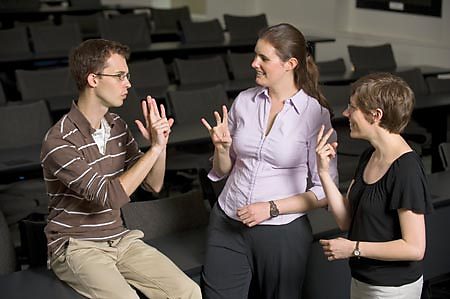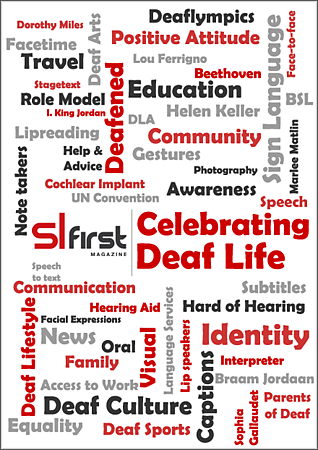Language & Communication13th March 2015
BSL - Maximising The Learning Opportunity
Making the best use of your time in the classroom and at home will improve your signing

When you get into your 50’s, going back to education can be a little daunting, particularly if you haven’t done any learning for a while. But, when my son started to get serious about a girl who was Deaf and a Sign Language user four years ago, I wanted to learn how to communicate in her first language. Registering for a Level 1 BSL course through evening classes a few years ago, I have now progressed to Level 4 and now feel comfortable talking to Chloe using sign.
 However, I must confess it’s not been easy, and if I’m honest, despite being an intelligent guy, I am no linguist, and the youngsters in the signing classes, seem to find it easier to learn. To keep pace and in terms of the exams, to get the best marks in the class every year so far, I have had to work harder and to learn through some good practices, and I thought it might be useful to share some of those thoughts with other learners in the hope they might be useful.
However, I must confess it’s not been easy, and if I’m honest, despite being an intelligent guy, I am no linguist, and the youngsters in the signing classes, seem to find it easier to learn. To keep pace and in terms of the exams, to get the best marks in the class every year so far, I have had to work harder and to learn through some good practices, and I thought it might be useful to share some of those thoughts with other learners in the hope they might be useful.
The first thing I did was to ask Chloe her advice about a choice of courses. Should I enrol at a college that has deaf BSL teachers or one that uses hearing tutors? The answer was unequivocal, “If you want to learn my language in the cultural way that I and other Deaf people use it, definitely go with a deaf teacher. It might be more difficult in respect of communication in the class room to start off with, but the longer term benefits far outweigh that.”
 Following her advice, I signed up at the first opportunity and was fortunate to have a Deaf teacher with over 10 years experience. I haven’t looked back. Involved regularly in the deaf community, the understanding I have gained from those shared experiences have served as an inspiration to learn both the language and the culture, the latter helping my signing no end.
Following her advice, I signed up at the first opportunity and was fortunate to have a Deaf teacher with over 10 years experience. I haven’t looked back. Involved regularly in the deaf community, the understanding I have gained from those shared experiences have served as an inspiration to learn both the language and the culture, the latter helping my signing no end.
Whilst the younger students seem able to learn the signs more quickly than me in class, I seem to remember more by the time of the next lesson, and importantly, how to use them more effectively in conversation. Talking to my fellow students over the years, I think some of them are missing out, and some of them fail the exams, simply because they don't follow some good learning practices.
Here are my top tips from my learner’s perspective:
1. Attend Class – it sounds obvious, but in adult learning I’m always surprised by the number and frequency of excuses that are given for not attending class. If you want to get the most out of your class, try and get as close to 100% attendance as you can.
2. Understand the basics – BSL is far more than signing with the hands. If you have a good teacher they will be teaching you about the importance of using eyes, face, referencing, role shift and more. Understanding these ‘foundations’ or ‘pillars’ of BSL will serve you well as you progress. See them as trivial or incidental and you will struggle to really get to the grips with the subject.
3. Make Notes – it seems daft for such a visual topic, but I find making notes useful, even if it is just a list of the signs covered so I know what I am trying to remember.
Make Notes – it seems daft for such a visual topic, but I find making notes useful, even if it is just a list of the signs covered so I know what I am trying to remember.
4. Practice – from the first lesson at Level 1, I have always practiced the signs taught in class, starting during my journey home, as I’m dropping off to sleep and then throughout the week. I’m trying to get the signs to go from my short term memory to my long term memory, and that rarely happens by chance. It’s worthwhile having a plan that works for you.
5.
6. BSL Mindset – There is a big difference between learning signs in the same sentence structure as English, and learning signs in BSL structure. My advice is to try and think BSL as soon as you can in your learning, so that you learn it the same way as you should be using it.
7. Use your signs – When you arrive for class, or have a break, lots of students go straight to voice communication in class. It’s actually a great opportunity to try out your signing with other students in a more relaxed conversational way, that than through the structured teaching. Not many students have the opportunity to practice their signing with other signers outside of the classroom, so use that time to sign away.
Use your signs – When you arrive for class, or have a break, lots of students go straight to voice communication in class. It’s actually a great opportunity to try out your signing with other students in a more relaxed conversational way, that than through the structured teaching. Not many students have the opportunity to practice their signing with other signers outside of the classroom, so use that time to sign away.
8. Connect with Deaf People – There are any number of deaf events both locally and nationally, and I really do think it helps if you go out of your way to attend some of these events, and to chat to deaf BSL users if you get the chance. Chat to your BSL teacher about it and get some advice about the events to go to and how to interact with Deaf people there.
9. Watch Others – The end of year assessments always test receptive and productive skills, so the more you practice both, the better the exam results. When other students are signing in class, watch them and try and understand what they are asking. If you were in a class with voice and another student was asking a lecturer a question you would listen in case it is of use to you. BSL class is no different, in fact, it’s probably more important, because the question and answer is of interest, but you are also testing your receptive skills.
10. Don’t Fight! – There are some consistent rules in BSL but there are also some variations. Challenging those inconsistencies wastes valuable classroom time and interferes with learning I think. I have seen students argue their point of view about a particular sign and it is bound to affect the ability to remember if you take a strong contradictory stance. The signs are what they are, the language belongs to the Deaf community, absorb it, is my advice.
11.
12. Fingerspelling/Fingerpatterns – Even I’m fed up of meeting people who say I know BSL, I learned the alphabet. Yeah, right. This is a crucial area of the language and you are well advised to spend a lot of time developing your knowledge, understanding and skills.  Please, please, please don’t get sucked into hearing induced bad practices using signs like man and chest for anchester or new and castle for Newcastle. That is not BSL, and whilst finger-spelling can be arduous until you get fluent at it, it’s important to know and follow the rules.
Please, please, please don’t get sucked into hearing induced bad practices using signs like man and chest for anchester or new and castle for Newcastle. That is not BSL, and whilst finger-spelling can be arduous until you get fluent at it, it’s important to know and follow the rules.
13. Precision – this is probably one of the most important bits of advice. Hand shapes and location are critical in using BSL correctly, with one false move potentially meaning you say something you had no intention of saying. If you are not absolutely sure how your teacher formed a sign, ask for clarification, and get it spot on. Making this your mantra in learning will serve you well, especially as the same hand shapes are often used in many different ways. If it was English you want to spell it right, this is BSL and you should want to sign it right.
I must say, that whilst I started learning BSL because of the lovely Chloe, I now learn it because I enjoy it. I use my sign as often as I can and that has developed my confidence. I regard my tutor as a friend and I enjoy being able to chat with other deaf people with awkwardness. Good luck with your learning.
Article by Steve Clarke, BSL Student
posted in Community / Language & Communication
13th March 2015





